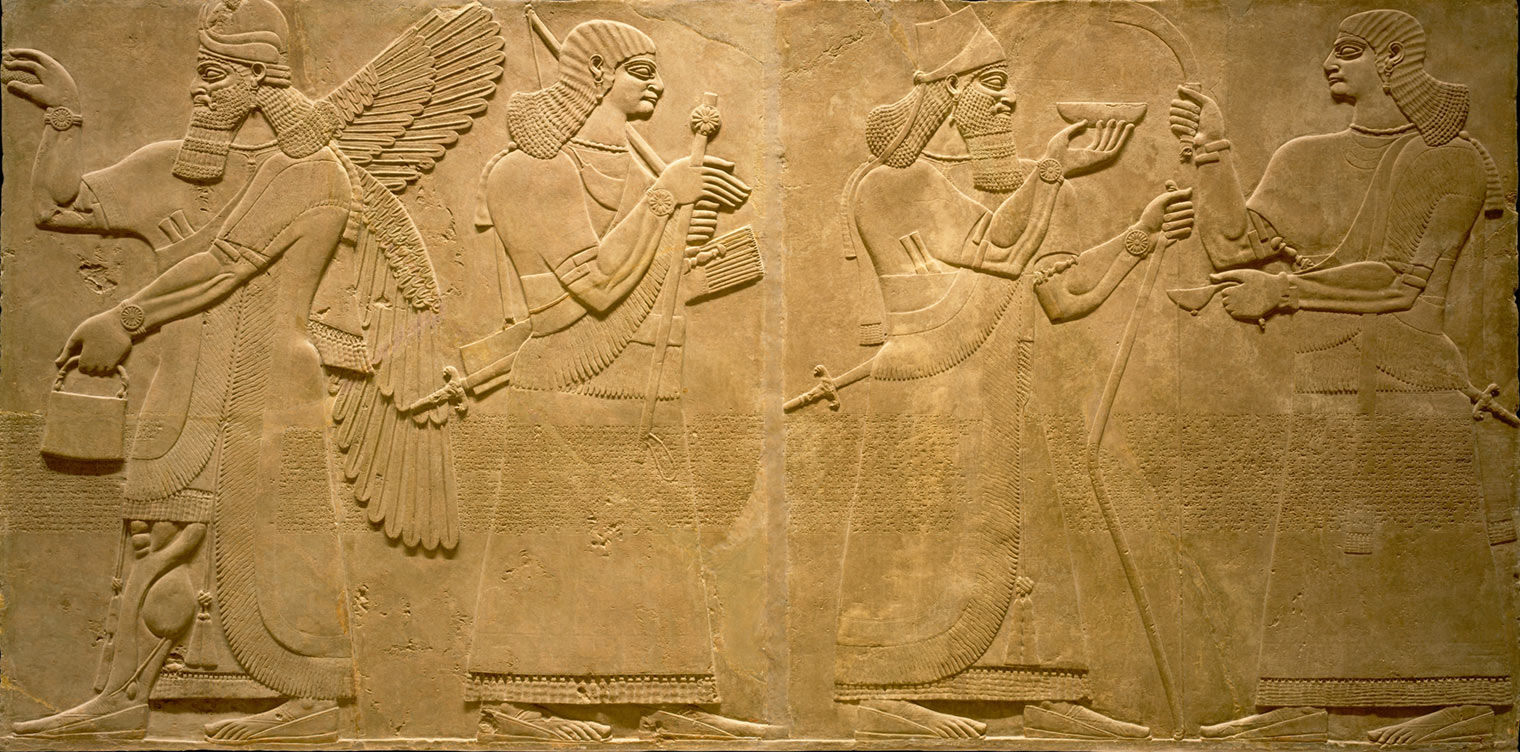Power in Ancient Mesopotamia

Relief panel, about 883–859 B.C. Neo-Assyrian, Mesopotamia, Nimrud (ancient Kalhu). Gypsum alabaster, 92 1/4 x 92 x 4 1/2 in. (234.3 x 233.7 x 11.4 cm). The Metropolitan Museum of Art, New York, Gift of John D. Rockefeller Jr., 1932 (32.143.4)
Collection Area: Ancient Near Eastern Art
Subject Areas: English Language Arts, Visual Arts, World History
Grades: Elementary School, Middle School
Topics/Themes: Power and Leadership, The Art of Belief
Goals
Students will be able to:
- understand the original functions and context of stone carvings from ancient Mesopotamia;
- identify ways leaders convey ideas through works of art; and
- use visual evidence to support their interpretations.
National Learning Standards
English Language Arts
NL-ENG.K-12.4 Communication Skills
NL-ENG.K-12.9 Multicultural Understanding
Visual Arts
NA-VA.K-4.3 Choosing and Evaluating a Range of Subject Matter, Symbols, and Ideas
NA-VA.K-4.4 Understanding the Visual Arts in Relation to History and Cultures
World History
NSS-WH.5-12.3 Era 3: Classical Traditions, Major Religions, and Giant Empires 1000 b.c.e.–300 c.e.
Common Core State Standards
English Language Arts
CCSS.ELA-Literacy.CCRA.R.1 Read closely to determine what the text says explicitly and to make logical inferences from it; cite specific textual evidence when writing or speaking to support conclusions drawn from the text.
CCSS.ELA-Literacy.CCRA.R.7 Integrate and evaluate content presented in diverse media and formats, including visually and quantitatively, as well as in words.
CCSS.ELA-Literacy.CCRA.SL.4 Present information, findings, and supporting evidence such that listeners can follow the line of reasoning and the organization, development, and style are appropriate to task, purpose, and audience.
Questions for Viewing
- What appears to be happening in this scene?
- A king, Ashurnasirpal II, is featured in the center wearing a conical hat with a small peak. What clues help convey that he is a leader?
- What roles might the other figures in the scene have? What do you see that makes you say that?
- This relief once decorated a palace of the great Assyrian king Ashurnasirpal II. What do you think he wanted to convey about himself?
- What are some ways leaders convey ideas about themselves today?
- A band of ancient writing, called cuneiform, spans the lower portion of the relief. Read an excerpt from the text (see citation in Resources section below). How does the writing compare to your initial impression of the relief?
Activity
Activity Setting: Classroom or Museum
Materials: Images of leaders (from magazines, newspapers, or other sources), a blank sheet of 8 1/2 x 11–inch paper, a pen or pencil, and a statement or transcript of a speech by one of the leaders represented in the images you collected
Subject Areas: English Language Arts, Visual Arts, World History
Duration: Approximately 30 minutes
Collect images of leaders from the country where you live. Compare and contrast the poses and facial expressions of the figures, the clothing and accessories they are wearing, and the settings featured in the images; a sheet of paper folded into thirds can provide a useful framework to collect your ideas about each element. Based on your observations of each image, what do you think each leader hoped to convey? (Hint: Be sure to include visual evidence to support your ideas.) Listen to speeches and/or read statements made by one of the leaders represented in the images you collected. Compare and contrast the messages in these texts with your impressions of the visual materials.
Resources
Benzel, Kim, Sarah B. Graff, Yelena Rakic, and Edith W. Watts. Art of the Ancient Near East: A Resource for Educators. New York: The Metropolitan Museum of Art, 2010.
"Wall Reliefs." Ancient Civilizations: Mesopotamia. The British Museum. Accessed March 22, 2013.
Ashurnasirpal's accomplishments are described in the so-called Standard Inscription that ran across the surface of many reliefs at his palace; read a translation of the Standard Inscription on the British Museum microsite named above. (It is useful to note that there are slight inconsistencies among the various translations of the Standard Inscription.)
"Mesopotamia, 1000 B.C.–1 A.D." In Heilbrunn Timeline of Art History. New York: The Metropolitan Museum of Art, 2000–.
Pre-visit Guide for Teachers: Art of the Ancient Near East (PDF)
Objects in the Museum's Collection Related to this Lesson
Statue of Gudea, about 2090 B.C. Neo-Sumerian, Mesopotamia, probably from Girsu (modern Tello). Diorite, 17 3/8 x 8 1/2 x 11 5/8 in. (44 x 21.5 x 29.5 cm). The Metropolitan Museum of Art, New York, Harris Brisbane Dick Fund, 1959 (59.2)
Portrait of the Emperor Caracalla, A.D. 212–217. Severan. Roman. Marble, H. 14 1/4 in. (36.2 cm). The Metropolitan Museum of Art, New York, Samuel D. Lee Fund, 1940 (40.11.1a)
Author: Adapted from a lesson by classroom teacher Kendra W. Brown, P. S. 154 Jonathan D. Hyatt, 2011